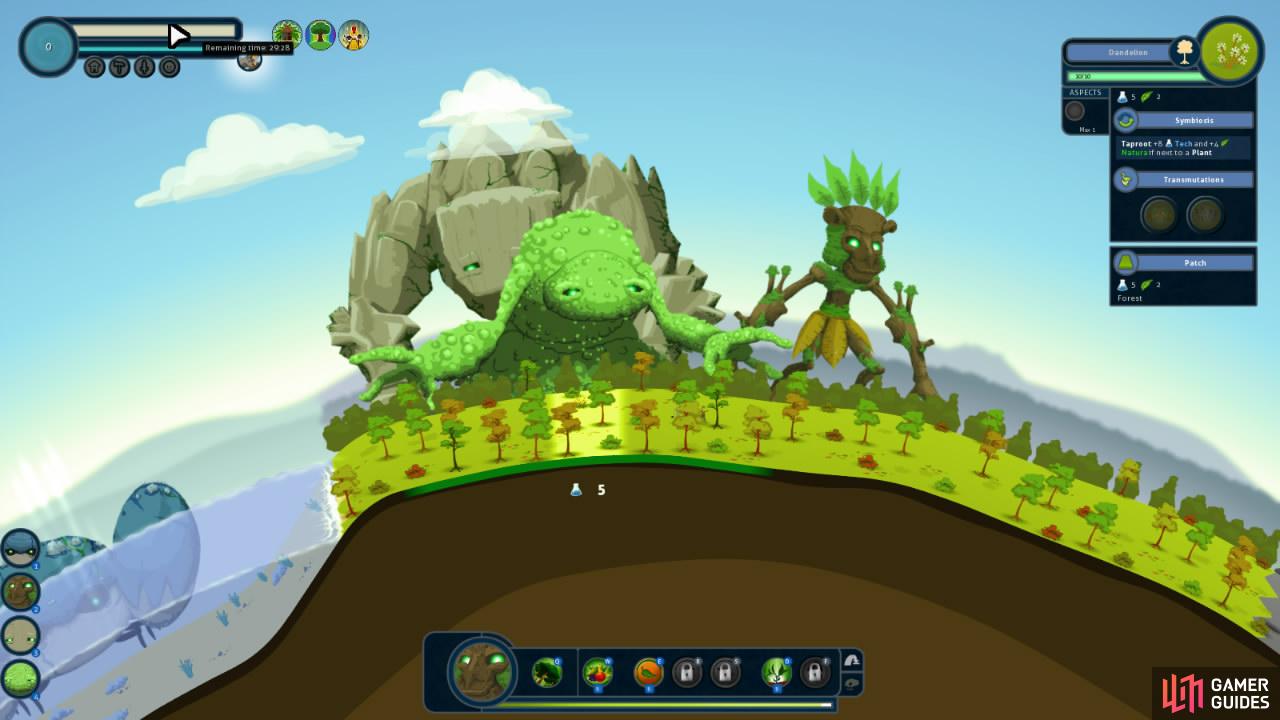What is Reus - Recap¶
Reus is part puzzle game, part god game. Your task is to lay the foundations for a settlement and then react to the demands of the people, using your knowledge of the Giant’s abilities to maximise the resource output with the tools you have to hand. Occasionally you’ll need to smush people if they get too rowdy, but that should only happen occasionally.
How to ‘Win’ - Recap¶
You ‘win’ Reus by meeting the requirements of its ‘developments’. You earn these awards by hitting their parameters by the end a game, or ‘era’. Complete enough developments and you’ll move on to the next tier of developments. Complete enough tier 2 and you’ll move on to tier 3, so on and so forth until you earn them all, along with ultimate satisfaction.
Starting a Game of Reus¶
1 - The most important thing to decide before starting any game of Reus is, ‘what development am I aiming for this time’. This decision will help establish a game plan in your head instantly and will inform your choices in terms of creating terrain and in how you grow your planet.
A few essential beginners tips to follow during any game of Reus include…
- To begin with, don’t try to maintain multiple villages unless you need to. Attempting this may simply lead to confusion or worse, failing your development. Focus on the development at hand.
- Don’t build too much terrain. Given a large space multiple settlers may appear on the same terrain source, denying border expansion once they clash. If you’re trying to maximise one village, expand one or two tiles at a time.
- Don’t grow attached to the resource points you build. It’s essential to work towards what your villagers want, not to get petty about one precious mineshaft having to be removed.
- Pause often. Pausing simply gives you time to think and work out your next move, helping you perform the most possible actions in the shortest amount of real game time possible.
2 – When the game begins, pause instantly. You should know what you need to start building so action it. If you’re going desert, invite the rock Giant to build a mountain (and use the Ocean Giant to remove the desert from one side if you want to contain the development area). If you’re going Forest or Swamp then have the Ocean Giant create water where he is standing and have the Forest or Swamp Giant already moving into position as this is happening, we want them to be generating the forest/swamp the moment the Ocean Giant starts hammering away.
3 – With your terrain created you’ll want to place resources with an eye to forcing settlers as close to the centre of a patch as possible. This usually means placing the first resource three or four tiles ‘into’ the edge of the territory, this will encourage a settlement to be created in the middle of a zone and make their growth as easy to visualise as possible. Placing the first resource with one of your ‘free’ giants will encourage the first settlement sooner, and you can always build over it later.
4 – From here you’ll need to adapt your designs to fit with your desired development, but this gives you a basic intro to any game in roughly 30 in-game seconds.
General Advice¶
- Pause Often. You’re going to get tired of hearing this one but pausing helps you maximise your productivity during real ‘game time’ by giving you unlimited room to stop, step back, and think about how to achieve the job at hand without the in-game clock ticking away.
- Focus. It’s easy to get distracted when you’re waiting for a village to gather the resources and finish a project but the devil makes work for idle hands, and a loss of focus could lead to missing development goals if you start occupying yourself elsewhere. If you’re doing anything, you should be placing extra resources on the tiles just outside your current settlement to ensure it is as resource-rich as possible (don’t forget that an animal outside of a village’s border’s may still add something to a village through its ‘animal range’).
- Focus 2. Your development takes pride above all, and how you ‘expand’ should adhere to this. If you’re working on a single village project then you should not make a massive forest just because you can – a second settlement might mess up your first village’s expansion (you could always just destroy them, of course, but that’s mean…).
- Apply Aspects. Your Giants are all equipped with aspects. Aspects are used to ‘transmute’ resources from one thing to another, but Aspects also apply a resource buff the moment you use them on a resource (assuming the resource has a free ‘slot’ to accept the buff. As such it’s worth applying Aspects to resources even if you don’t plan on transmuting it as it’s essentially a free resource buff of your choice.
- Animals. Animals have a range in which they spread resources, so it’s worth placing them on the world ‘outside’ a village’s borders as their range will allow them to feed the village from outside its typical range.
- Move Around. It’s easy to leave your giants stood somewhere unhelpful, so remember to keep them hanging around where you need them, not on the other side of the planet.



 Sign up
Sign up
No Comments